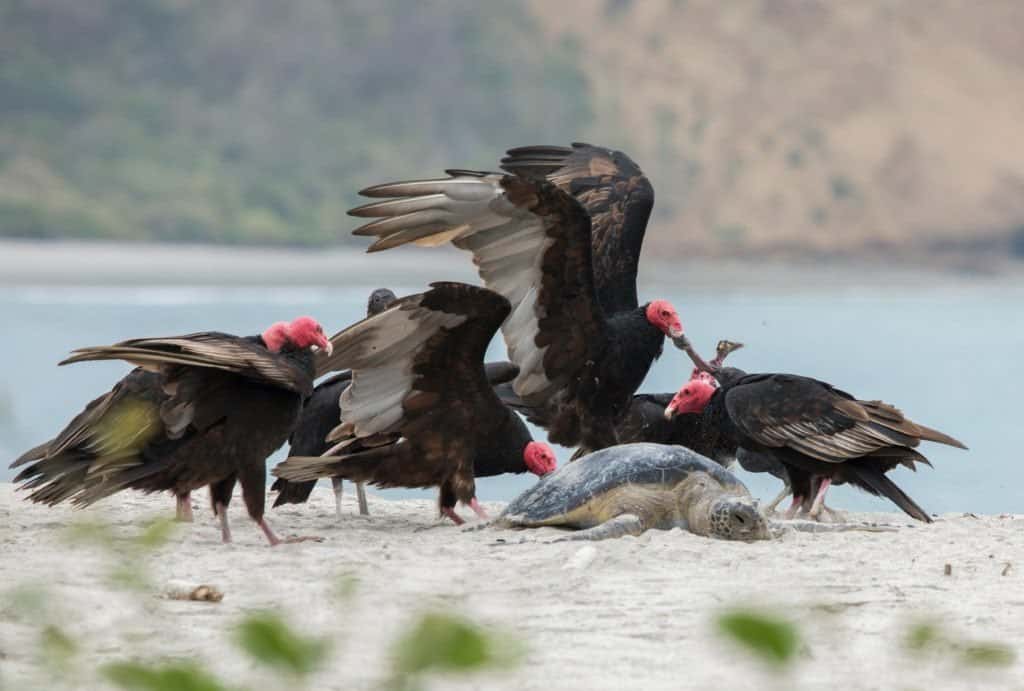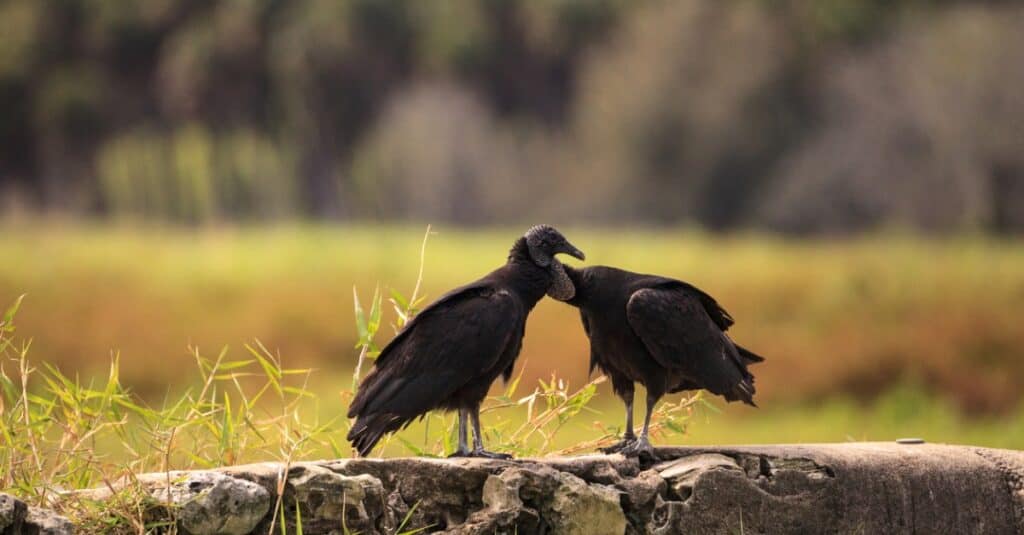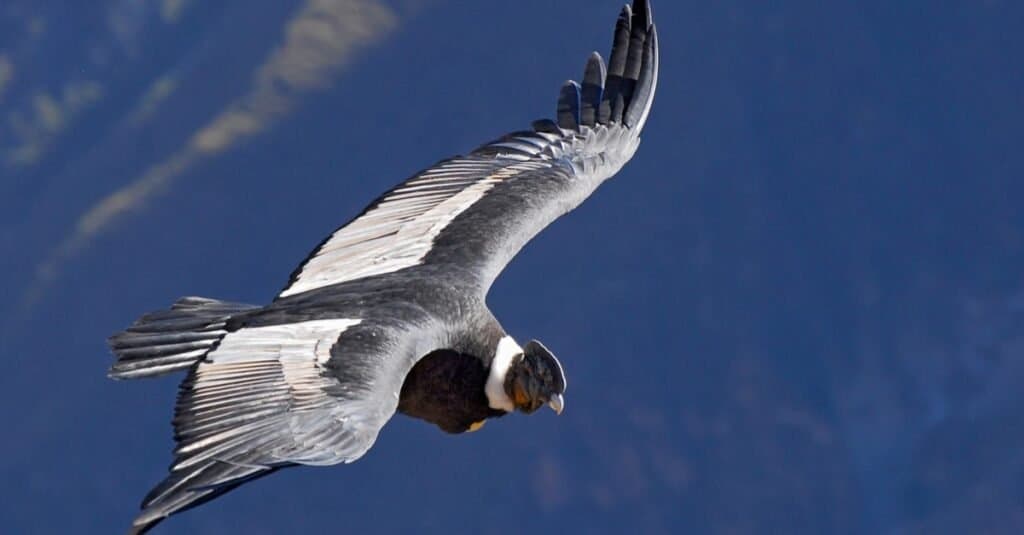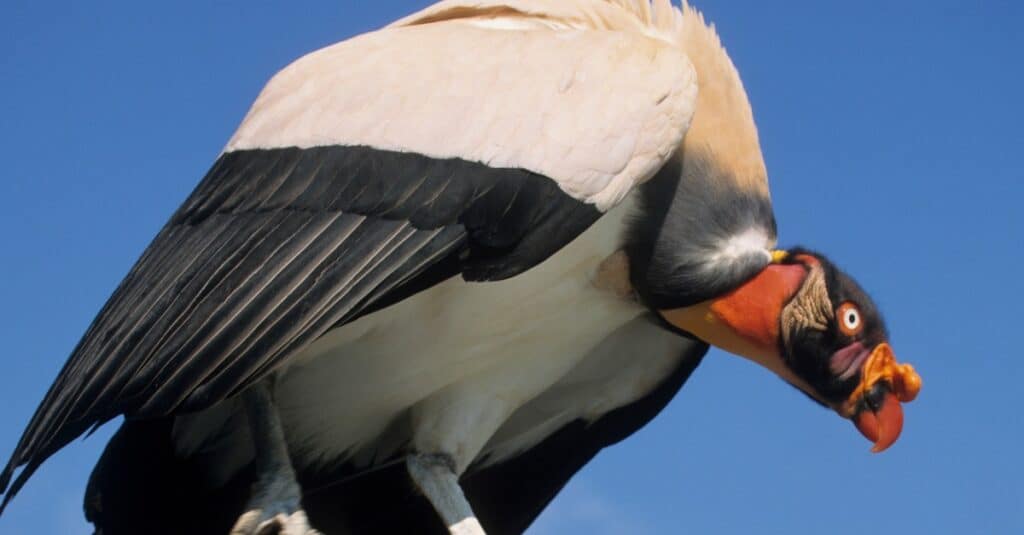We’ve all been curious about “group” names before! Calling a flock of crows a “murder” or a group of pugs a “grumble” can be quite revealing about an animal you are referencing. While it isn’t always the case, learning the name of a group helps you identify their behaviors. Even more so, learning about the grouping behaviors of an animal is a great way to appreciate the species as a whole. Vultures are some of the most interesting birds on earth, but if “murder” has already been taken for crows, what would a group of vultures be? Let’s look and learn about a group of vultures: what they’re called & vulture group behavior.
What is a group of vultures called?

A group of vultures is called a “wake”, “kettle”, or “committee”, depending on what they’re doing.
©Ana Dracaena/Shutterstock.com
A gathering of vultures is called a “wake”, “kettle”, “committee” or, just generally, a “flock”.
An important note when naming groups of things is that it’s often done more for amusement than an actual purpose. When it comes to birds as a whole, flock is the general term. Anything more than that, and it’s likely just for fun. Still, there’s nothing wrong with having some fun!
When vultures fly in formation, they are given the term “kettle”. This term isn’t actually exclusive to vultures, however. A kettle is any formation of birds of prey that are moving together. You could call a migrating group of hawks, for example, a “kettle of hawks”.
A “wake” of vultures is probably the most general usage in reference to the group, but it can also specifically mean when the birds are feeding on a corpse. While there isn’t a lot of information on this, it seems that the term is a taxonomical reference to a funeral wake. A funeral wake is part of a vigil where you watch over a body before it is buried. When considering the vulture’s close connection to death, this seems to make a lot of sense.
A lesser-used reference to a group of vultures is called a “committee”. A committee of vultures refers to when vultures gather together on a perch. This is often seen across the United States, specifically on power lines, cell towers, or other tall perches. It is rather imposing and does resemble a bunch of old men in a committee.
Why do vultures group up?

Vultures group up to feed, roost, and migrate.
©iStock.com/LagunaticPhoto
As the various labels would suggest, vultures group up for various reasons. Let’s look at the most common.
The most common reason that vultures group up is for food. Vultures gather in large groups to eat dead meat. More meat generally means more vultures. When there is a particularly large carcass (a deer or cow), there can be dozens of birds, all vying for a position at the feast. When vultures begin to congregate, it attracts the attention of other vultures, creating a growth cycle.
Another potential reason vultures would group up is to sleep. Some species are rather social, often gathering to sleep and seek protection from potential predators or elements through numbers. Roosting vultures can be seen all over the world but is particularly uncommon in any other birds of prey.
A third reason that vultures would group up is to migrate. Migration is an essential element of survival for many vultures. During certain times of the year, vulture flocks will head south towards Mexico and Central America. In those migrating flocks, there can be as many as 10,000 birds moving together.
The final reason that vultures gather would be for mating and raising chicks. For the days leading up to the laying of an egg, a nesting pair will spend entire days together, sitting near their nesting or laying site. Once the eggs hatch, the vultures will often stay together as a family group.
Do Vultures Get Sick From Eating Dead Animals?
Vultures can consume the carcass of an animal infected with rabies, distemper, or other diseases without falling ill. Additionally, their feeding habits prevent mammals like opossums, raccoons, or dogs from eating the contaminated animal and spreading the disease to other wildlife.
After consuming the deceased flesh, vultures’ incredibly potent stomach acids initiate the digestion process, breaking down the flesh so thoroughly that they can even obliterate the prey’s DNA.
However, while this powerful digestive system eliminates certain harmful microbes, it selectively screens out others and concentrates them in the intestines.
Are vultures aggressive in groups?
There is a common misnomer that vultures kill domestic animals, but it is rather unfounded. This belief in Africa led to the killing and near extinction of a few species of vultures. There are occasional reports of groups of vultures killing extremely wounded or sick animals, but vultures never take down large healthy animals for the sake of food. Even if a vulture wanted to kill an animal, it would be extremely tough. They have weak talons that are incredibly dull. Vultures are much better adapted to eating rotting flesh.
Vultures can be aggressive towards other scavengers who are trying to take away a kill, but outside of that, they are generally conflict-avoidant.
Are certain species of vultures more solitary than others?

Most vultures group together, but some species prefer a more solitary lifestyle.
©Cezary Wojtkowski/Shutterstock.com
With over 24 species of vulture on the earth, there are some behavioral differences between them.
Turkey vultures are among the most social of all the vultures, often gathering in groups to migrate, feed, or simply roost together. Additionally, black vultures group up (sometimes with turkey vultures) in large roosts, with the number of vultures reaching into the hundreds.
Andean condors often fly solo but do group up together, just in much smaller numbers than either the black or turkey vultures further north. They’re also the largest vulture species in the world as measured by wingspan. King vultures, however, are primarily solitary. They will feed with other groups but don’t intentionally seek out the presence of their kin.
Do different species of vulture group up together?

King vultures follow other scavengers to carcasses, but then help them by opening up holes in the body with their strong beaks.
©iStock.com/Michel VIARD
Vultures have an interesting interdependence on one another. Here are a few examples.
Black and turkey vultures often rest in communal roosts together, sometimes to the tune of a few hundred birds. These vulture committees allow them to rest without the fear of other predators attacking them: the more eyes, the more safety, generally.
An interesting dependence can be seen between king vultures and great and lesser yellow-headed vultures. King vultures don’t have a sense of smell and rely on their sight to find food. Yellow-headed vultures, however, often find themselves at the site of a carcass well before any other scavengers arrive. The king vulture will follow the yellow-headed vultures to the prey, and since the yellow-headed vultures aren’t strong enough to cut open tough hide, the king vulture begins the feeding.
King vultures have the strongest beaks out of the vultures, and smaller scavengers depend on them to be able to access larger prey sources. Although the three vulture species are technically competitors, they benefit from one another – the king vulture can find food, and the yellow-headed vultures can access the food.
The photo featured at the top of this post is © Raul Baena/Shutterstock.com
Thank you for reading! Have some feedback for us? Contact the AZ Animals editorial team.






